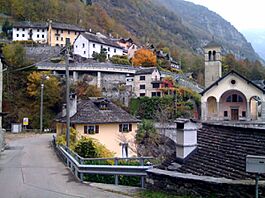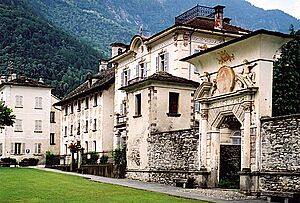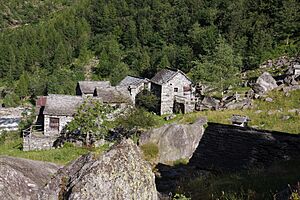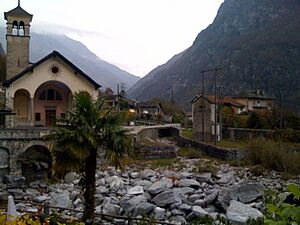Cevio facts for kids
Quick facts for kids
Cevio
|
||
|---|---|---|

Cevio village
|
||
|
||
| Country | Switzerland | |
| Canton | Ticino | |
| District | Vallemaggia | |
| Area | ||
| • Total | 151.3 km2 (58.4 sq mi) | |
| Elevation | 421 m (1,381 ft) | |
| Population
(Dec 2020 )
|
||
| • Total | 1,142 | |
| • Density | 7.548/km2 (19.549/sq mi) | |
| Postal code |
6675
|
|
| Localities | Bignasco, Cavergno | |
| Surrounded by | Bedretto, Bosco/Gurin, Brione (Verzasca), Campo (Vallemaggia), Cerentino, Formazza (IT-VB), Lavizzara, Linescio, Maggia | |
Cevio is an important town in the Vallemaggia district of Ticino, Switzerland. It's known as the capital of this district. In 2006, Cevio became larger when it joined with the nearby villages of Bignasco and Cavergno. These villages used to be separate towns.
Contents
Discovering Cevio's Past
Cevio was first written about in the year 1335, where it was called Zevio. For a long time, it has been the main town in its district.
Key Moments in Cevio's History
In 1858, the village of Linescio became its own separate municipality. A very important person, Chancellor Giovan Angelo Franzoni, who was in charge for 36 years, built a grand house called a Patrician palazzo outside the town center.
After World War II, people started to focus on protecting the town's history. In 1962, the Museo di Valmaggia (Valmaggia Museum) was created. Its goal was to save and display old items from the valley. The museum opened in 1963 in the Palazzo Franzoni, becoming the first museum of its kind in Ticino.
In 2006, the villages of Cavergno and Bignasco officially became part of Cevio. Bignasco tried to stay separate but was unsuccessful in court.
Exploring Cevio's Landscape
Cevio covers an area of about 151.42 square kilometers (58.46 sq mi). A small part, 0.4%, is used for farming. Forests cover about 6.3% of the land.
About 0.5% of Cevio is covered by buildings and roads. Rivers and lakes make up 0.6% of the area. The remaining 1.9% is unproductive land, like rocky areas.
Cevio's Unique Location
The town is located in the Vallemaggia district. It sits where the Maggia and Rovana rivers meet. Cevio is made up of several small settlements spread out.
One interesting hamlet is Boschetto, which is almost empty but still looks like a 17th-century village. You can also find many rocks with unusual cup markings in the area.
Cevio is about 23 kilometers (14 mi) northwest of Locarno. The mountain Pizzo Alzasca stands tall over the town.
Cevio's Coat of Arms
The coat of arms for Cevio shows a golden shield. On it, Saint Maurice rides a silver horse. He holds a red flag with a silver cross. At the bottom of the shield are three golden fleur-de-lis.
People of Cevio
Cevio has a population of about 476 people (as of December 2004). About 14.7% of the people living here are from other countries (as of 2008). Over ten years (1997–2007), the population slightly decreased by 4.6%.
Languages Spoken in Cevio
Most people in Cevio speak Italian (about 77.9%). German is the second most common language (10.9%). Spanish is spoken by about 4.2% of the population.
Some people also speak French or Romansh. The local people often speak an old alpine dialect of the Lombard language. However, standard Italian remains the official language.
Who Lives in Cevio?
Out of 476 residents, about 76.47% are Swiss citizens. Many non-Swiss residents come from Italy, Spain, Portugal, Bosnia and Herzegovina, and Sri Lanka. The higher number of non-Swiss people is partly because of jobs in local quarries and the hospital.
In 2008, about 50.7% of the population was male and 49.3% female. Most people (about 27.6%) were born in Cevio and still lived there in 2000. Others were born in the same canton (28.2%) or elsewhere in Switzerland (12.1%). About 26.4% were born outside Switzerland.
Cevio's Population Over Time
Cevio's population has changed over the years. In 1591, there were about 700 people. By 1850, it grew to 927. After Linescio separated, the population dropped to 602 in 1860. It then decreased to 398 by 1900. In 2000, the population was 497.
Important Historical Sites
Several buildings in Cevio are considered very important Swiss heritage sites. These include the Respini-Moretti House, the Case Franzoni, and the Museo di Valmaggia.
Other important sites are the Church of S. Maria del Ponte alla Rovana, the Parish Church of S. Maria Assunta e S. Giovanni (with its ossuary and portico), and the Pretorio. The villages of Bignasco, Boschetto, Cevio/Rovana, and the Val Bavona are also recognized as important heritage sites.
Cevio's Economy
In 2007, Cevio had a low unemployment rate of 1.51%. In 2005, about 32 people worked in farming. There were 14 businesses in this sector.
Jobs in Cevio
About 148 people worked in the secondary sector (like manufacturing and construction). There were 19 businesses in this area. The largest number of people, 372, worked in the tertiary sector (services). This sector had 66 businesses.
In 2008, there were 461 full-time jobs in Cevio. Most jobs were in construction (86 jobs) and healthcare (96 jobs). Other jobs were in sales, transportation, hotels, education, and more.
Commuting and Tourism
Many people travel into Cevio for work (252 workers). Fewer people (89) travel out of Cevio for work. This means Cevio offers more jobs than it has local workers. About 6.7% of workers coming into Cevio are from outside Switzerland.
Most people (57.8%) use a private car to get to work. About 7.4% use public transportation. In 2009, Cevio had 7 hotels with a total of 71 rooms and 141 beds for visitors.
Religion in Cevio
According to the 2000 census, most people in Cevio (78.3%) were Roman Catholic. About 7.2% belonged to the Swiss Reformed Church. A small number of people belonged to other Christian churches, or were Islamic or Buddhist. About 5.63% of the population did not belong to any church.
Cevio's Climate
Cevio has a mild, Temperate climate. Between 1981 and 2010, it rained or snowed about 106.1 days each year. The average yearly rainfall was about 1713 millimeters (67.4 inches).
Weather Patterns
September was the wettest month, with about 215 mm (8.5 inches) of rain or snow. May had the most days of precipitation (13 days). February was the driest month, with about 65 mm (2.6 inches) of precipitation.
The average yearly temperature in Cevio is about 10.2°C (50.4°F). January is the coldest month, averaging 1.1°C (34°F). July is the warmest month, averaging 19.5°C (67.1°F).
| Climate data for Cevio weather station elev. 417 meters (1,368 ft) | |||||||||||||
|---|---|---|---|---|---|---|---|---|---|---|---|---|---|
| Month | Jan | Feb | Mar | Apr | May | Jun | Jul | Aug | Sep | Oct | Nov | Dec | Year |
| Mean daily maximum °C (°F) | 4.3 (39.7) |
5.9 (42.6) |
10.2 (50.4) |
14.1 (57.4) |
18.1 (64.6) |
21.9 (71.4) |
24.5 (76.1) |
23.4 (74.1) |
20 (68) |
14.9 (58.8) |
9.1 (48.4) |
5.6 (42.1) |
14.3 (57.8) |
| Daily mean °C (°F) | 1 (34) |
2.5 (36.5) |
5.9 (42.6) |
9.5 (49.1) |
13.5 (56.3) |
17.0 (62.6) |
19.5 (67.1) |
18.7 (65.7) |
15.6 (60.1) |
10.9 (51.6) |
5.6 (42.1) |
2.3 (36.1) |
10.2 (50.4) |
| Mean daily minimum °C (°F) | −2.1 (28.2) |
−0.9 (30.4) |
1.6 (34.9) |
5 (41) |
9.0 (48.2) |
12 (54) |
14.5 (58.1) |
14.0 (57.2) |
11.3 (52.3) |
6.9 (44.4) |
2.1 (35.8) |
−0.9 (30.4) |
6.0 (42.9) |
| Average precipitation mm (inches) | 69 (2.7) |
64 (2.5) |
110 (4.4) |
150 (6) |
190 (7.6) |
190 (7.3) |
160 (6.3) |
180 (7.1) |
180 (7) |
180 (7.1) |
140 (5.5) |
79 (3.1) |
1,690 (66.4) |
Education in Cevio
In Cevio, about 29.4% of the population has finished upper secondary education. This is schooling after middle school. About 8.0% have gone on to higher education, like university.
Student Life in Cevio
As of 2009, there were 197 students in Cevio. The Ticino education system offers up to three years of optional kindergarten. In Cevio, 23 children were in kindergarten.
Primary school lasts for five years. There were 62 students in standard primary schools and 2 in special schools. For middle school, students can choose a two-year program followed by job training, or a four-year program to prepare for university. There were 49 students in the two-year middle school and 17 in the four-year program.
Beyond Middle School
Upper secondary school prepares students for a trade or for university. Some students attend school while doing an internship (3-4 years). Others go to school full-time for a year, then do an internship. In Cevio, 7 students were full-time vocational students, and 33 were part-time.
There was also a three-year professional program for jobs like engineering or nursing, with 4 students enrolled. In 2000, 236 students came to Cevio for school from other towns. Only 16 residents of Cevio went to school outside the municipality.
|
See also
 In Spanish: Cevio para niños
In Spanish: Cevio para niños











